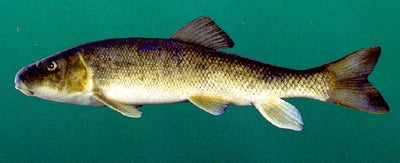SCIENTIFIC NAME: Catostomus commersoni
CHARACTERISTICS: The white sucker has 55 to 85 lateral line scales—more than any other catostomid species in Alabama. Scale size and location are also distinctive. On the front of the body, scales are distinctly smaller and more crowded; behind the dorsal fin base, they are larger and less crowded. The eye is midway between the tip of the snout and the rear of the gill cover. The mouth is large, and the lips are papillose, with a bilobed lower lip that is nearly twice as thick as the upper lip. For most of the year, the body is gray to brown on the back, shading to cream on the venter. During the spawning season, however, it becomes purplish, with a dark, well-defined lateral band. The ventral fins are pale yellow, especially in spring. All other fins are generally clear to pale gray.
ADULT SIZE: 10 to 16 in (254 to 406 mm)
DISTRIBUTION: The Tennessee River drainage marks the southern limit of this species’ range (Lee and Kucas, 1978). Collection records indicate that, although never abundant, it is widely distributed in northern Alabama. In 1991, we collected white suckers at eight stations.
HABITAT AND BIOLOGY: White suckers prefer springs and small streams. Like northern hog suckers and some redhorse species, white suckers usually occur in or just downstream of gravelly riffles, where they feed on aquatic insects and other invertebrates. On 6 November 1991, we collected two white suckers just inside the mouth of Glover Cave in Madison County. Since white suckers are not normally found in caves, these fishes probably became stranded there when steam levels in the area decreased. White suckers spawn over gravel shoals in March and April. Etnier and Starnes (1993) report that stomach contents of white suckers collected in Tennessee included 50 percent benthic invertebrates and 50 percent unidentified matter. Carlander (1969) reports that females grow faster than males. The life span may last from seven to 10 years, although errors in reading the annuli on scales of older individuals sometimes result in underestimates.
ORIGINAL DESCRIPTION: Lacepède described the white sucker in 1803.
ETYMOLOGY:
Catostomus means inferior mouth.
Commersoni is in honor of Phelebert Commerson, the French naturalist.
The copyrighted information above is from Fishes of Alabama and the Mobile Basin.






